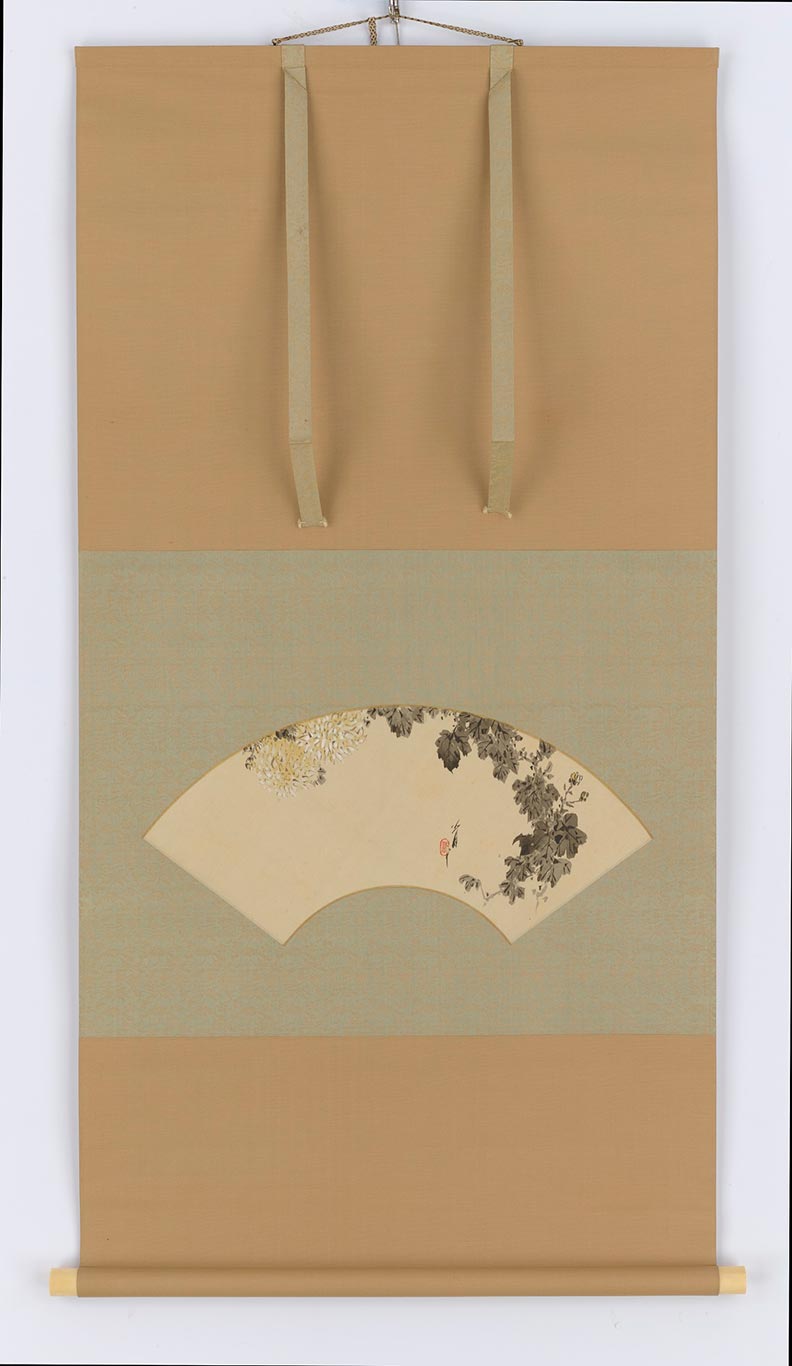
Read on to learn about the journey of this hanging scroll from Tokyo, Japan, to Washington, DC, in the second feature of our Unseen Art History blog series, which highlights provenance stories about how objects came to the Freer Gallery of Art and Arthur M. Sackler Gallery, the Smithsonian’s National Museum of Asian Art.
Japanese artist Watanabe Seitei (1851–1918) painted the hanging scroll September (Chrysanthemum), from the series Flowers of the Twelve Months, during the late nineteenth or early twentieth century. Budding and blooming chrysanthemums on the scroll herald the month of September. In Japan, chrysanthemum blossoms mark the beginning of the autumnal season and serve as the focal point of festive celebrations on September 9, Japan’s Kiku no Sekku (National Chrysanthemum Day).
A successful businesswoman in Tokyo, Tome Fujikura (1898–1992) acquired this hanging scroll, along with the other eleven scrolls in the Flowers of the Twelve Months series, sometime during the 1920s or early 1930s, before the outbreak of World War II. She kept the series in her home for private occasions and seasonal display. It is unclear from whom Fujikura purchased these scrolls.
Tome Fujikura’s choice to include the Flowers of the Twelve Months in her collection is somewhat unusual, as Watanabe Seitei was—and remains—more popular with overseas audiences rather than those in Japan. Seitei participated regularly in international exhibitions, including the 1876 Centennial International Exhibition in Philadelphia, Pennsylvania, and the 1878 Exposition Universelle in Paris, France, during which he displayed his monumental painting Pigeons at Sensōji, which is now part of the Freer Gallery of Art’s collection.
In 1941, Tome’s only son, Toshio Fujikura (1924–2021), enrolled at the Chiba Institute of Technology. His enrollment, however, was short lived; with Japan’s entry into World War II, Toshio’s mother sent him to the Japanese countryside to work on a farm, presumably for safety. He finished his studies after the conclusion of the war, earning a medical degree with a specialization in obstetrics and gynecology. In 1953, he received a competitive fellowship at Johns Hopkins University Hospital in Baltimore, Maryland. Upon completing the fellowship, he returned home to Japan.

Across the Pacific Ocean, Yuka Yasui (1927–2021) lived with her family in Hood River, Oregon. She led a quiet life until 1942, when Executive Order 9066 went into effect. She and her family—along with thousands of other American citizens of Japanese ancestry—were forced from their home and incarcerated in an American concentration camp. First sent to a concentration camp in Pinedale, California, they were later transferred to another one in Tule Lake, California. The United States government released her in 1943 and, accompanied by her brother, she moved to Denver, Colorado, where she finished school. Yuka earned two master’s degrees, one in nursing and another in public health, and received a competitive Fulbright fellowship to study at the Institute of Public Health in Japan.
During Yuka’s tenure in Japan, she met Toshio Fujikura, who had returned from his studies in Baltimore. The couple fell in love, married, and eventually returned to Yuka’s home state of Oregon. Around this time, Toshio’s mother gifted her son and daughter-in-law her impressive collection of Japanese painting, including September (Chrysanthemum).
Throughout their long life together, Toshio and Yuka Fujikura lived in many places, as Dr. Fujikura was an accomplished pathologist who received appointments at both American and Japanese institutions. Presumably, the Fujikuras brought the collection along with them wherever they moved.
In June 2013, the couple approached the National Museum of Asian Art, offering the collection that Tome Fujikura had assembled in the years before World War II as a gift in her memory. This generous gift complemented and expanded the Freer’s notable collection of Watanabe Seitei paintings, prints, and illustrated books. The painted series Flowers of the Twelve Months, of which September (Chrysanthemum) is a part, offers an opportunity for scholars and museum visitors alike to explore Seitei’s talent in rendering kachō-ga (bird-and-flower images) with great sensitivity to the color and depth of nature’s beauty.
Joanna Gohmann
Joanna M. Gohmann received her PhD in the History of Art from the University of North Carolina at Chapel Hill. She is the Provenance Researcher & Objects Historian at the Freer Gallery of Art and Arthur M. Sackler Gallery, the Smithsonian’s National Museum of Asian Art.


